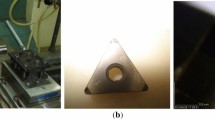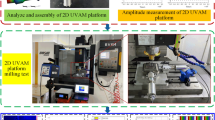Abstract
The chip formation mechanism of the wave-edge end mill for machining of titanium alloy has been presented in this study. The steady-state contact model between the tool and the workpiece during the milling process of the wave-edge milling cutter has been established. Then, the influence of different wave arrangement of the cutting tool on the workpiece steady-state contact, the chip morphology, and tool wear behavior has been revealed. The chip formation and tool cutting performance of different designs, including the left-handed staggered, right-handed staggered, and interlaced wave-edge end mill, have been evaluated by the milling experimental of Ti6Al4V. The results indicate that the interleaved arrangement significantly improves the tool life, which is 33% longer than that of the left-handed staggered wave-edge end mill and 167% longer than that of the right-handed wave-edge end mill.











Similar content being viewed by others
References
Zhang S, Li JF, Sun J, Jiang F (2010) Tool wear and cutting forces variation in high-speed end-milling ti-6al-4v alloy. Int J Adv Manuf Technol 46(1-4):69–78
Zha X, Chen FB, Jiang F et al (2019) Correlation of the fatigue impact resistance of bilayer and nanolayered PVD coatings with their cutting performance in machining Ti6Al4V. Ceram Int 45(12):14704–14717
Su X, Wang G, Yu JC et al (2016) Predictive model of milling force for complex profile milling. Int J Adv Manuf Technol 87(5-8):1653–1662
Kilic ZM, Altintas Y (2016) Generalized mechanics and dynamics of metal cutting operations for unified simulations. Int J Mach Tool Manu 104:1–13
Zhang ZH, Zheng L, Li ZZ et al (2002) Numerical model to predict milling forces for a wavy-edge milling cutter. J Tsinghua Univ (Sci Technol) 42(6):766–768 772
Jiang F, Zhang T, Yan L (2016) Analytical model of milling forces based on time-variant sculptured shear surface. Int J Mech Sci 115-116:190–201
Zhang Z, Zheng L, Li Z et al (2003) A cutting force model for a wave-edge end milling cutter. Int J Adv Manuf Technol 21(6):403–410
Wang J, Yang C (2003) Angle and frequency domain force models for a roughing end mill with a sinusoidal edge profile. Int J Mach Tool Manu 43(14):1509–1520
Abdulhakim A, Okafor A (2016) Effects of geometric parameters of wavy-edge bull-nose helical end-mill on cutting force prediction in end-milling of Inconel 718 under MQL cooling strategy. J Manuf Process 23:102–114
Okafor C, Abdulhakim A (2016) Development of a mechanistic cutting force model for wavy-edge bull-nose helical end-milling of inconel 718 under emulsion cooling strategy. Appl Math Model 40(4):2637–2660
Compeán FI, Olvera D, Campa FJ, de López LNL, Elías-Zúniga A, Rodríguez CA (2012) Characterization and stability analysis of a multivariable milling tool by the enhanced multistage homotopy perturbation method. Int J Mach Tools Manuf 57:27–33
Mannan MA (1985) Wear behaviour of serrated-form roughing end milling cutters. In: Tobias SA (ed) Proceedings of the Twenty-Fifth International Machine Tool Design and Research Conference. Palgrave, London
Kull Neto H, Diniz AE, Pederiva R (2016) Tool life and surface roughness in the milling of curved hardened-steel surfaces. Int J Adv Manuf Technol 87(9-12):2983–2995
Guo J, Zhang JG, Pan YA, Kang RK, Namba Y, Shore P, Yue XB, Wang BR, Guo DM (2020) A critical review on the chemical wear and wear suppression of diamond tools in diamond cutting of ferrous metals. Int J Extreme Manuf 2:012001
Zha X, Jiang F, Xu X (2018) Investigating the high frequency fatigue failure mechanisms of mono and multilayer PVD coatings by the cyclic impact tests. Surf Coat Technol 344:689–701
Funding
This research is financially supported by the National Science and Technology Major Project “Research and Application of Complete Process Technology for High Performance Machining Technology of Aviation Titanium Alloy Structural Parts” (Grant number 2018ZX04042001).
Author information
Authors and Affiliations
Corresponding author
Additional information
Publisher’s note
Springer Nature remains neutral with regard to jurisdictional claims in published maps and institutional affiliations.
Rights and permissions
About this article
Cite this article
Jiang, E., Huang, L. & Jiang, F. Research on the tool wear mechanism of the wave-edge end mill based on the tool-chip contact analysis. Int J Adv Manuf Technol 108, 801–808 (2020). https://doi.org/10.1007/s00170-020-05424-5
Received:
Accepted:
Published:
Issue Date:
DOI: https://doi.org/10.1007/s00170-020-05424-5




